Soft Skills in Hospitality: Effective Strategies and Analysis
VerifiedAdded on 2022/09/09
|7
|1493
|14
Homework Assignment
AI Summary
This assignment delves into the critical role of soft skills within the hospitality industry, exploring various scenarios and providing insightful analyses. It begins by examining different communication styles—passive, aggressive, and assertive—in various situations, evaluating their effectiveness. The assignment then differentiates between win-win and win-lose situations, highlighting the benefits of a collaborative approach. It also identifies key qualities of successful employees, such as Jake, emphasizing the importance of knowledge, skills, and behavior in the workplace. Furthermore, the assignment underscores the significance of excellent customer service in fostering customer loyalty and driving sales, and it provides actionable steps for improving service orientation. The communication process, including encoding, planning, medium, decoding, and feedback, is also discussed, along with barriers to effective communication and strategies for overcoming them, like staff training. The assignment is well-referenced and provides a comprehensive overview of essential soft skills in the hospitality sector.
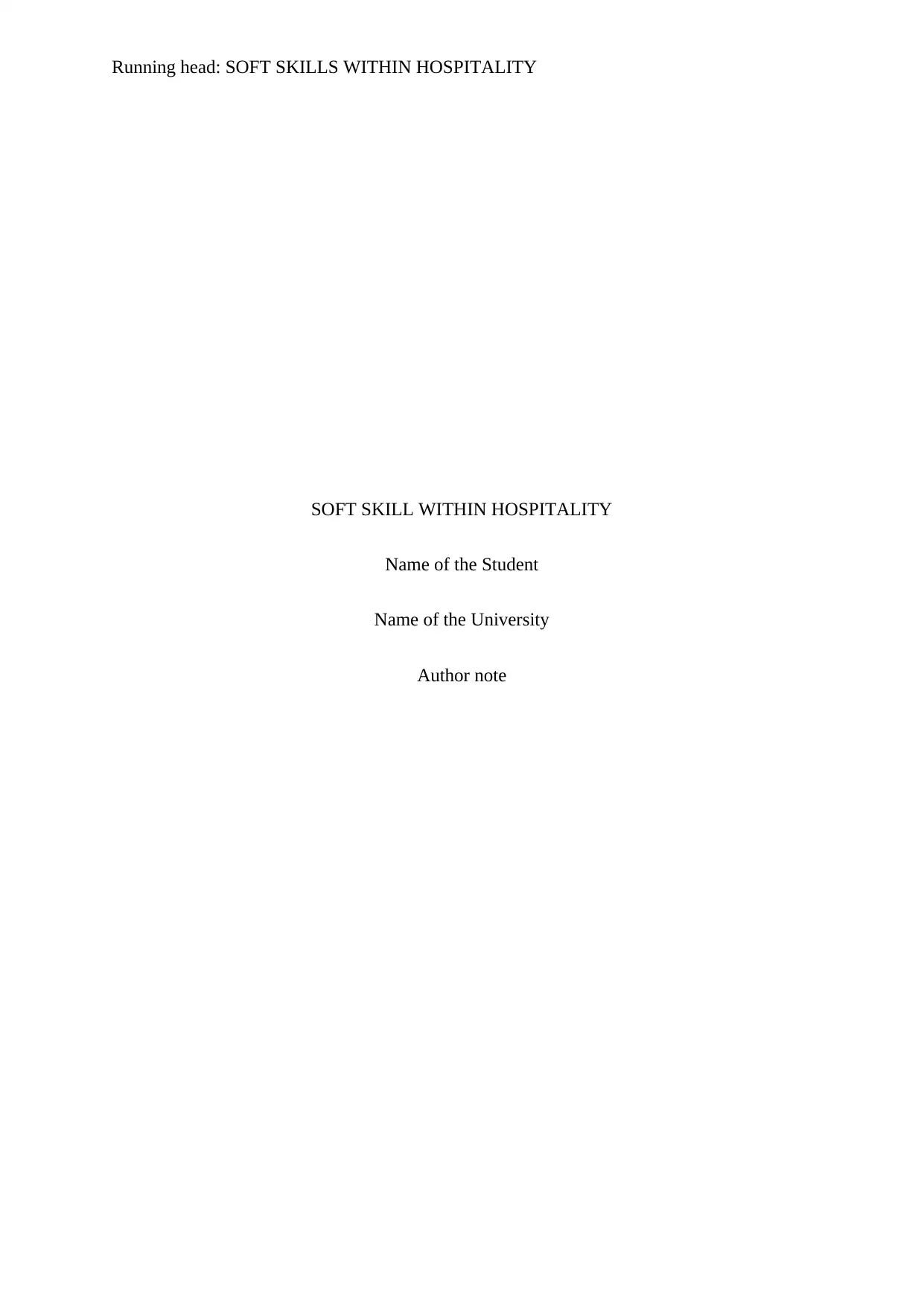
Running head: SOFT SKILLS WITHIN HOSPITALITY
SOFT SKILL WITHIN HOSPITALITY
Name of the Student
Name of the University
Author note
SOFT SKILL WITHIN HOSPITALITY
Name of the Student
Name of the University
Author note
Paraphrase This Document
Need a fresh take? Get an instant paraphrase of this document with our AI Paraphraser
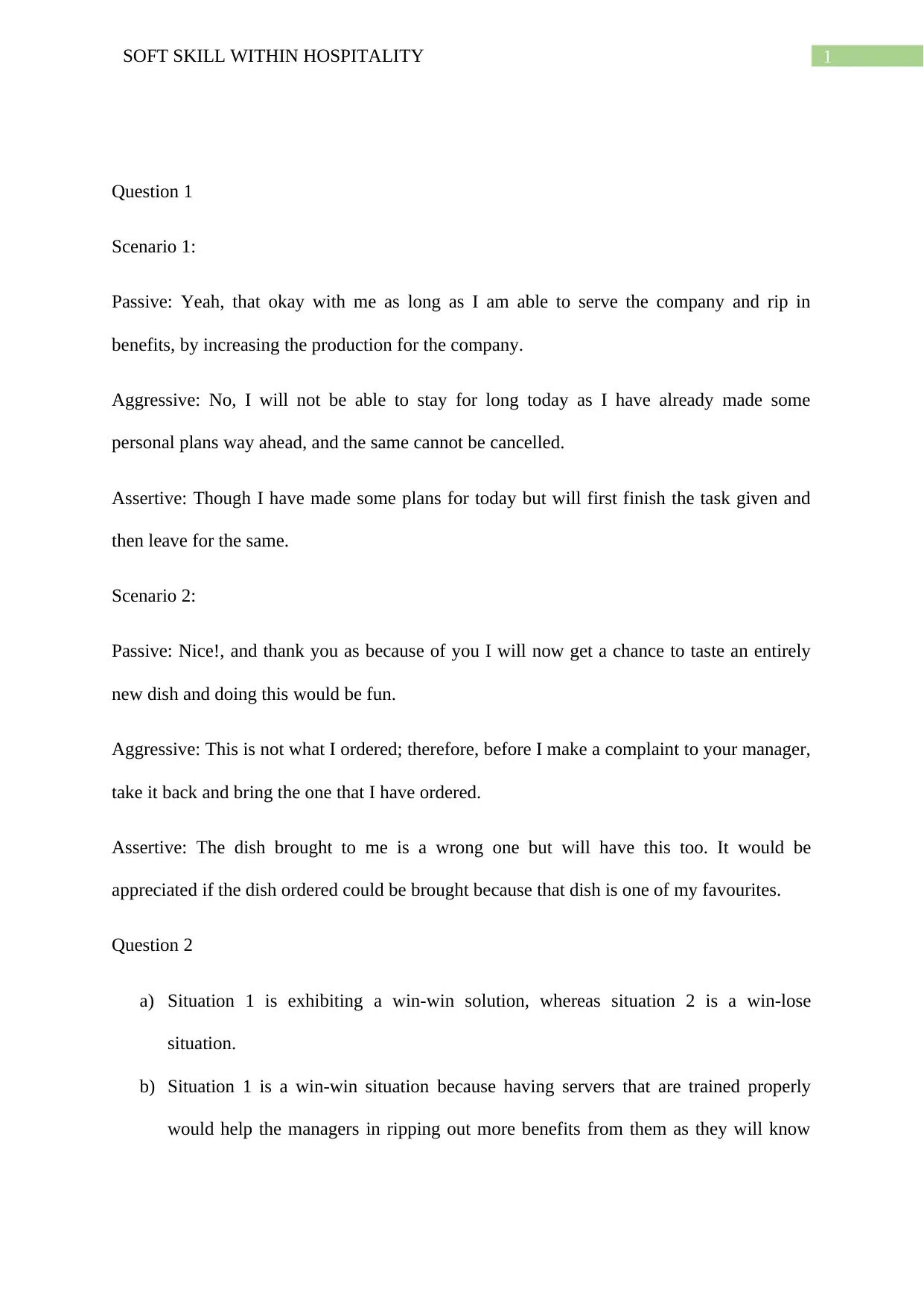
1SOFT SKILL WITHIN HOSPITALITY
Question 1
Scenario 1:
Passive: Yeah, that okay with me as long as I am able to serve the company and rip in
benefits, by increasing the production for the company.
Aggressive: No, I will not be able to stay for long today as I have already made some
personal plans way ahead, and the same cannot be cancelled.
Assertive: Though I have made some plans for today but will first finish the task given and
then leave for the same.
Scenario 2:
Passive: Nice!, and thank you as because of you I will now get a chance to taste an entirely
new dish and doing this would be fun.
Aggressive: This is not what I ordered; therefore, before I make a complaint to your manager,
take it back and bring the one that I have ordered.
Assertive: The dish brought to me is a wrong one but will have this too. It would be
appreciated if the dish ordered could be brought because that dish is one of my favourites.
Question 2
a) Situation 1 is exhibiting a win-win solution, whereas situation 2 is a win-lose
situation.
b) Situation 1 is a win-win situation because having servers that are trained properly
would help the managers in ripping out more benefits from them as they will know
Question 1
Scenario 1:
Passive: Yeah, that okay with me as long as I am able to serve the company and rip in
benefits, by increasing the production for the company.
Aggressive: No, I will not be able to stay for long today as I have already made some
personal plans way ahead, and the same cannot be cancelled.
Assertive: Though I have made some plans for today but will first finish the task given and
then leave for the same.
Scenario 2:
Passive: Nice!, and thank you as because of you I will now get a chance to taste an entirely
new dish and doing this would be fun.
Aggressive: This is not what I ordered; therefore, before I make a complaint to your manager,
take it back and bring the one that I have ordered.
Assertive: The dish brought to me is a wrong one but will have this too. It would be
appreciated if the dish ordered could be brought because that dish is one of my favourites.
Question 2
a) Situation 1 is exhibiting a win-win solution, whereas situation 2 is a win-lose
situation.
b) Situation 1 is a win-win situation because having servers that are trained properly
would help the managers in ripping out more benefits from them as they will know
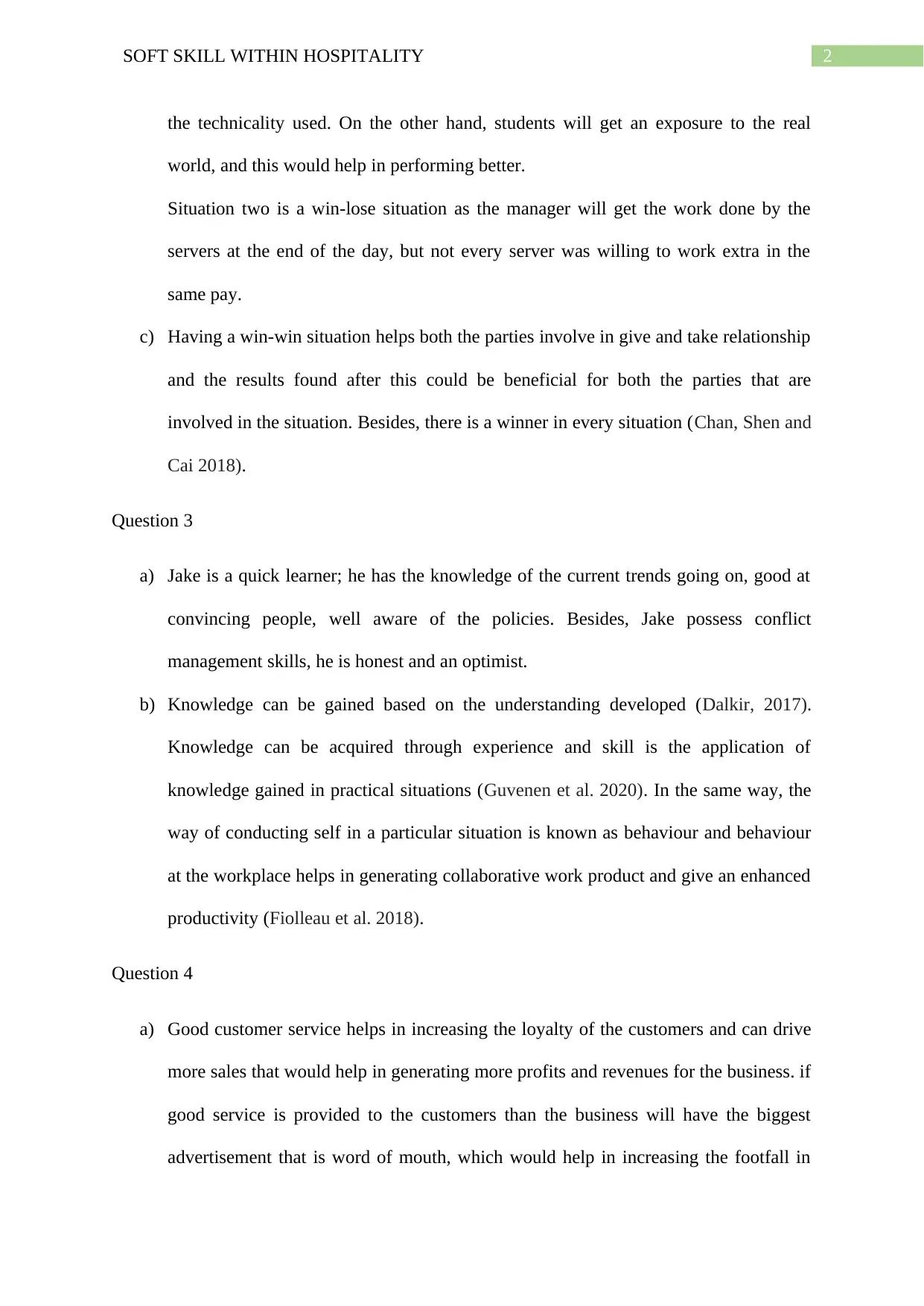
2SOFT SKILL WITHIN HOSPITALITY
the technicality used. On the other hand, students will get an exposure to the real
world, and this would help in performing better.
Situation two is a win-lose situation as the manager will get the work done by the
servers at the end of the day, but not every server was willing to work extra in the
same pay.
c) Having a win-win situation helps both the parties involve in give and take relationship
and the results found after this could be beneficial for both the parties that are
involved in the situation. Besides, there is a winner in every situation (Chan, Shen and
Cai 2018).
Question 3
a) Jake is a quick learner; he has the knowledge of the current trends going on, good at
convincing people, well aware of the policies. Besides, Jake possess conflict
management skills, he is honest and an optimist.
b) Knowledge can be gained based on the understanding developed (Dalkir, 2017).
Knowledge can be acquired through experience and skill is the application of
knowledge gained in practical situations (Guvenen et al. 2020). In the same way, the
way of conducting self in a particular situation is known as behaviour and behaviour
at the workplace helps in generating collaborative work product and give an enhanced
productivity (Fiolleau et al. 2018).
Question 4
a) Good customer service helps in increasing the loyalty of the customers and can drive
more sales that would help in generating more profits and revenues for the business. if
good service is provided to the customers than the business will have the biggest
advertisement that is word of mouth, which would help in increasing the footfall in
the technicality used. On the other hand, students will get an exposure to the real
world, and this would help in performing better.
Situation two is a win-lose situation as the manager will get the work done by the
servers at the end of the day, but not every server was willing to work extra in the
same pay.
c) Having a win-win situation helps both the parties involve in give and take relationship
and the results found after this could be beneficial for both the parties that are
involved in the situation. Besides, there is a winner in every situation (Chan, Shen and
Cai 2018).
Question 3
a) Jake is a quick learner; he has the knowledge of the current trends going on, good at
convincing people, well aware of the policies. Besides, Jake possess conflict
management skills, he is honest and an optimist.
b) Knowledge can be gained based on the understanding developed (Dalkir, 2017).
Knowledge can be acquired through experience and skill is the application of
knowledge gained in practical situations (Guvenen et al. 2020). In the same way, the
way of conducting self in a particular situation is known as behaviour and behaviour
at the workplace helps in generating collaborative work product and give an enhanced
productivity (Fiolleau et al. 2018).
Question 4
a) Good customer service helps in increasing the loyalty of the customers and can drive
more sales that would help in generating more profits and revenues for the business. if
good service is provided to the customers than the business will have the biggest
advertisement that is word of mouth, which would help in increasing the footfall in
⊘ This is a preview!⊘
Do you want full access?
Subscribe today to unlock all pages.

Trusted by 1+ million students worldwide
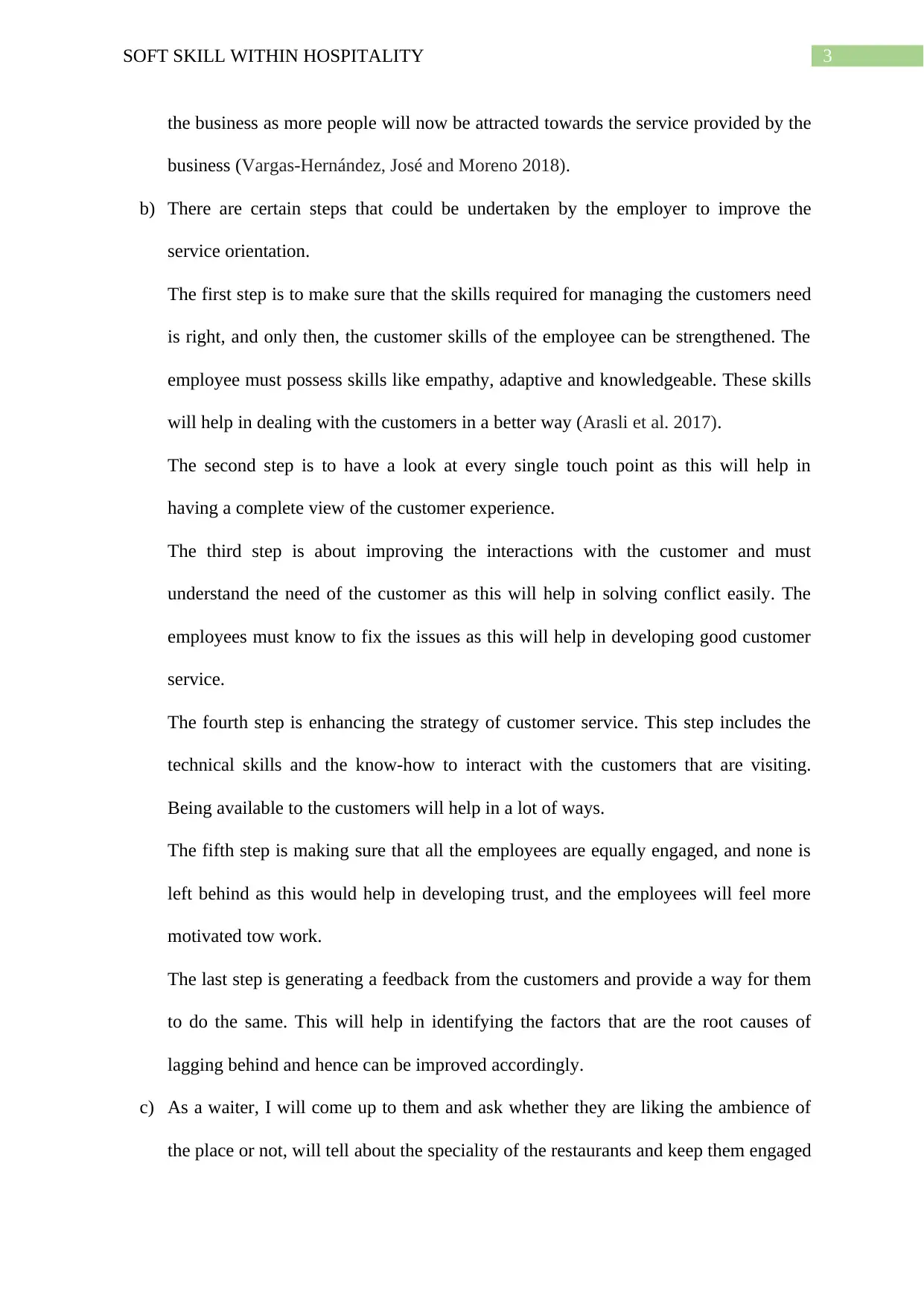
3SOFT SKILL WITHIN HOSPITALITY
the business as more people will now be attracted towards the service provided by the
business (Vargas-Hernández, José and Moreno 2018).
b) There are certain steps that could be undertaken by the employer to improve the
service orientation.
The first step is to make sure that the skills required for managing the customers need
is right, and only then, the customer skills of the employee can be strengthened. The
employee must possess skills like empathy, adaptive and knowledgeable. These skills
will help in dealing with the customers in a better way (Arasli et al. 2017).
The second step is to have a look at every single touch point as this will help in
having a complete view of the customer experience.
The third step is about improving the interactions with the customer and must
understand the need of the customer as this will help in solving conflict easily. The
employees must know to fix the issues as this will help in developing good customer
service.
The fourth step is enhancing the strategy of customer service. This step includes the
technical skills and the know-how to interact with the customers that are visiting.
Being available to the customers will help in a lot of ways.
The fifth step is making sure that all the employees are equally engaged, and none is
left behind as this would help in developing trust, and the employees will feel more
motivated tow work.
The last step is generating a feedback from the customers and provide a way for them
to do the same. This will help in identifying the factors that are the root causes of
lagging behind and hence can be improved accordingly.
c) As a waiter, I will come up to them and ask whether they are liking the ambience of
the place or not, will tell about the speciality of the restaurants and keep them engaged
the business as more people will now be attracted towards the service provided by the
business (Vargas-Hernández, José and Moreno 2018).
b) There are certain steps that could be undertaken by the employer to improve the
service orientation.
The first step is to make sure that the skills required for managing the customers need
is right, and only then, the customer skills of the employee can be strengthened. The
employee must possess skills like empathy, adaptive and knowledgeable. These skills
will help in dealing with the customers in a better way (Arasli et al. 2017).
The second step is to have a look at every single touch point as this will help in
having a complete view of the customer experience.
The third step is about improving the interactions with the customer and must
understand the need of the customer as this will help in solving conflict easily. The
employees must know to fix the issues as this will help in developing good customer
service.
The fourth step is enhancing the strategy of customer service. This step includes the
technical skills and the know-how to interact with the customers that are visiting.
Being available to the customers will help in a lot of ways.
The fifth step is making sure that all the employees are equally engaged, and none is
left behind as this would help in developing trust, and the employees will feel more
motivated tow work.
The last step is generating a feedback from the customers and provide a way for them
to do the same. This will help in identifying the factors that are the root causes of
lagging behind and hence can be improved accordingly.
c) As a waiter, I will come up to them and ask whether they are liking the ambience of
the place or not, will tell about the speciality of the restaurants and keep them engaged
Paraphrase This Document
Need a fresh take? Get an instant paraphrase of this document with our AI Paraphraser
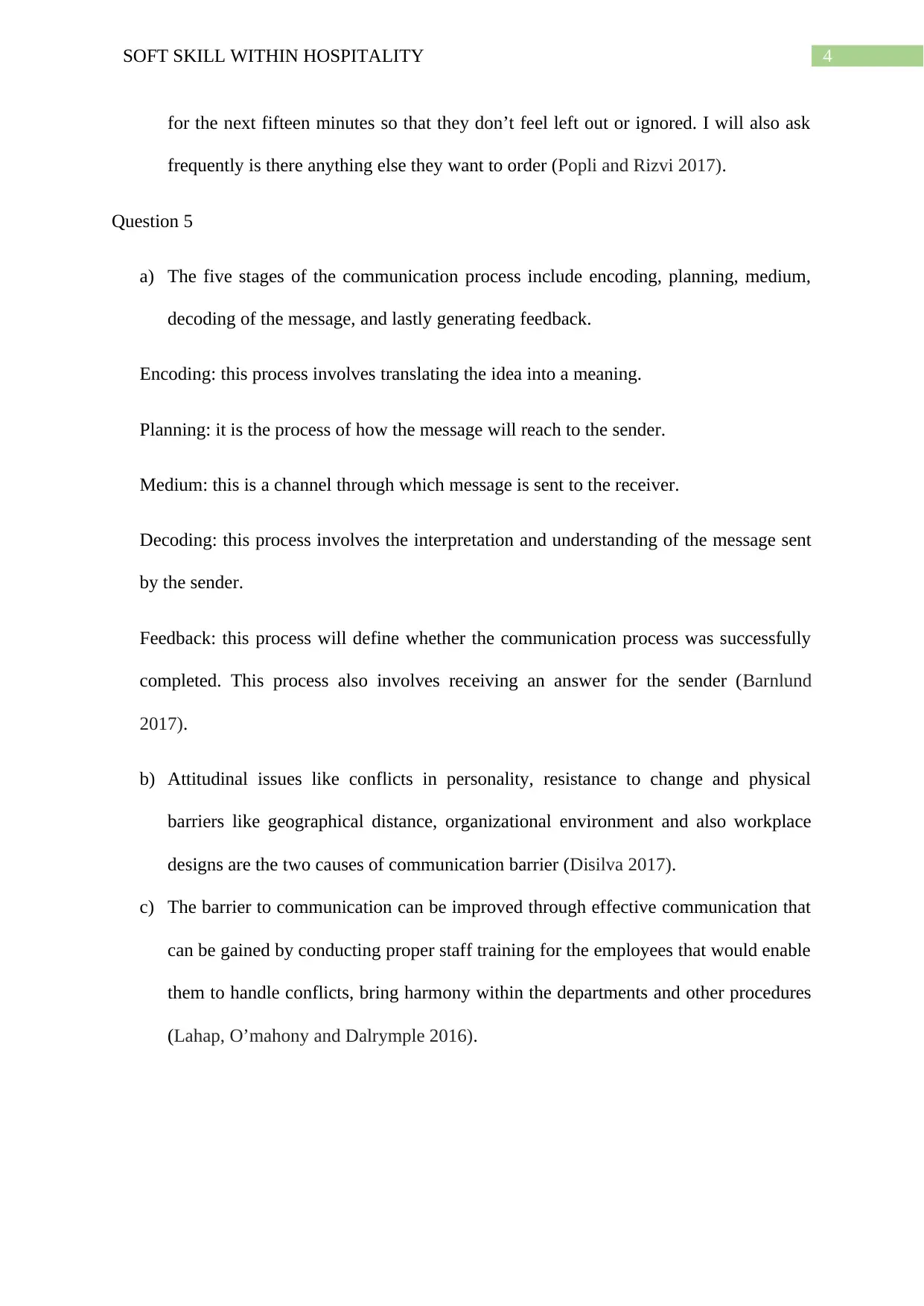
4SOFT SKILL WITHIN HOSPITALITY
for the next fifteen minutes so that they don’t feel left out or ignored. I will also ask
frequently is there anything else they want to order (Popli and Rizvi 2017).
Question 5
a) The five stages of the communication process include encoding, planning, medium,
decoding of the message, and lastly generating feedback.
Encoding: this process involves translating the idea into a meaning.
Planning: it is the process of how the message will reach to the sender.
Medium: this is a channel through which message is sent to the receiver.
Decoding: this process involves the interpretation and understanding of the message sent
by the sender.
Feedback: this process will define whether the communication process was successfully
completed. This process also involves receiving an answer for the sender (Barnlund
2017).
b) Attitudinal issues like conflicts in personality, resistance to change and physical
barriers like geographical distance, organizational environment and also workplace
designs are the two causes of communication barrier (Disilva 2017).
c) The barrier to communication can be improved through effective communication that
can be gained by conducting proper staff training for the employees that would enable
them to handle conflicts, bring harmony within the departments and other procedures
(Lahap, O’mahony and Dalrymple 2016).
for the next fifteen minutes so that they don’t feel left out or ignored. I will also ask
frequently is there anything else they want to order (Popli and Rizvi 2017).
Question 5
a) The five stages of the communication process include encoding, planning, medium,
decoding of the message, and lastly generating feedback.
Encoding: this process involves translating the idea into a meaning.
Planning: it is the process of how the message will reach to the sender.
Medium: this is a channel through which message is sent to the receiver.
Decoding: this process involves the interpretation and understanding of the message sent
by the sender.
Feedback: this process will define whether the communication process was successfully
completed. This process also involves receiving an answer for the sender (Barnlund
2017).
b) Attitudinal issues like conflicts in personality, resistance to change and physical
barriers like geographical distance, organizational environment and also workplace
designs are the two causes of communication barrier (Disilva 2017).
c) The barrier to communication can be improved through effective communication that
can be gained by conducting proper staff training for the employees that would enable
them to handle conflicts, bring harmony within the departments and other procedures
(Lahap, O’mahony and Dalrymple 2016).
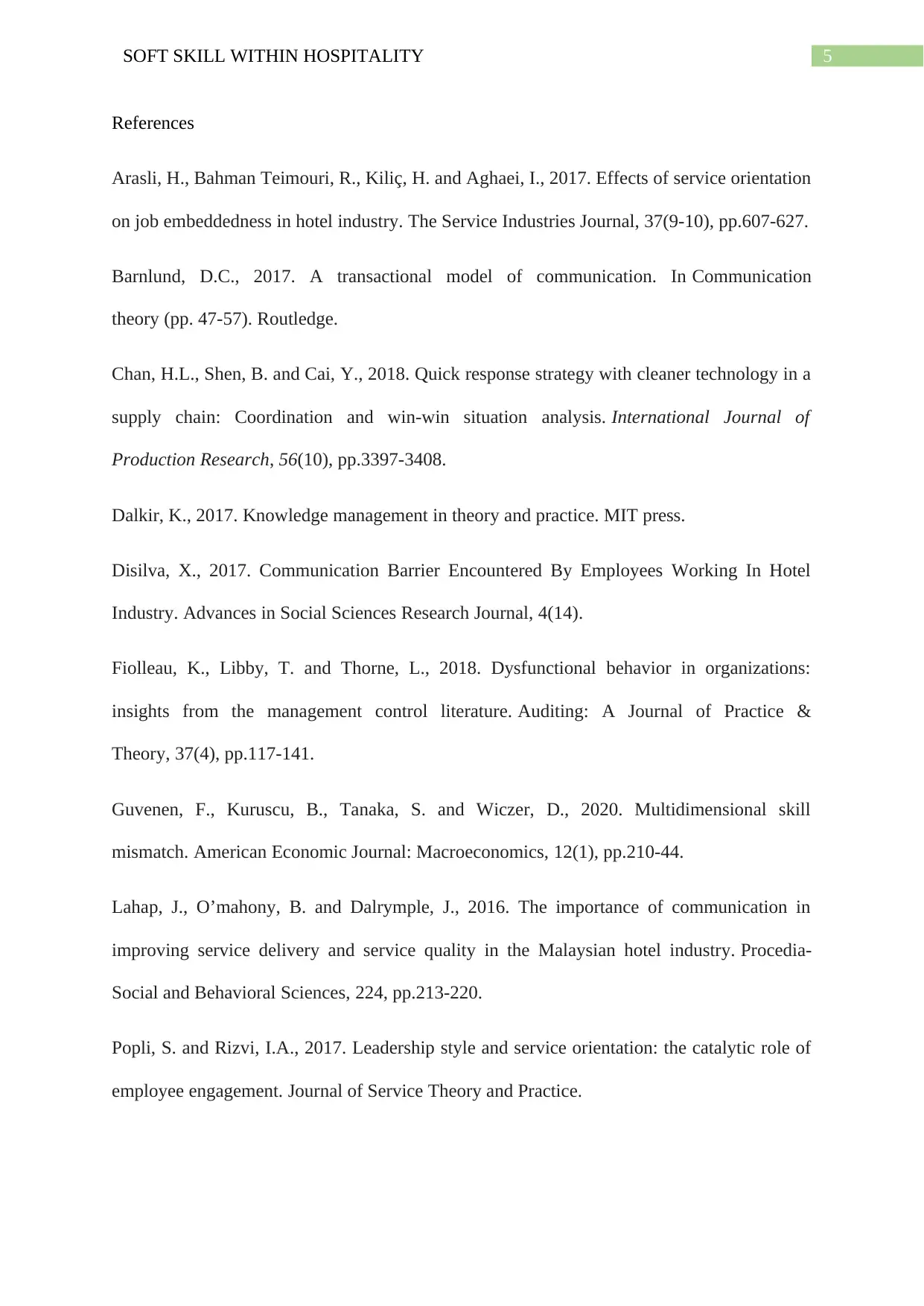
5SOFT SKILL WITHIN HOSPITALITY
References
Arasli, H., Bahman Teimouri, R., Kiliç, H. and Aghaei, I., 2017. Effects of service orientation
on job embeddedness in hotel industry. The Service Industries Journal, 37(9-10), pp.607-627.
Barnlund, D.C., 2017. A transactional model of communication. In Communication
theory (pp. 47-57). Routledge.
Chan, H.L., Shen, B. and Cai, Y., 2018. Quick response strategy with cleaner technology in a
supply chain: Coordination and win-win situation analysis. International Journal of
Production Research, 56(10), pp.3397-3408.
Dalkir, K., 2017. Knowledge management in theory and practice. MIT press.
Disilva, X., 2017. Communication Barrier Encountered By Employees Working In Hotel
Industry. Advances in Social Sciences Research Journal, 4(14).
Fiolleau, K., Libby, T. and Thorne, L., 2018. Dysfunctional behavior in organizations:
insights from the management control literature. Auditing: A Journal of Practice &
Theory, 37(4), pp.117-141.
Guvenen, F., Kuruscu, B., Tanaka, S. and Wiczer, D., 2020. Multidimensional skill
mismatch. American Economic Journal: Macroeconomics, 12(1), pp.210-44.
Lahap, J., O’mahony, B. and Dalrymple, J., 2016. The importance of communication in
improving service delivery and service quality in the Malaysian hotel industry. Procedia-
Social and Behavioral Sciences, 224, pp.213-220.
Popli, S. and Rizvi, I.A., 2017. Leadership style and service orientation: the catalytic role of
employee engagement. Journal of Service Theory and Practice.
References
Arasli, H., Bahman Teimouri, R., Kiliç, H. and Aghaei, I., 2017. Effects of service orientation
on job embeddedness in hotel industry. The Service Industries Journal, 37(9-10), pp.607-627.
Barnlund, D.C., 2017. A transactional model of communication. In Communication
theory (pp. 47-57). Routledge.
Chan, H.L., Shen, B. and Cai, Y., 2018. Quick response strategy with cleaner technology in a
supply chain: Coordination and win-win situation analysis. International Journal of
Production Research, 56(10), pp.3397-3408.
Dalkir, K., 2017. Knowledge management in theory and practice. MIT press.
Disilva, X., 2017. Communication Barrier Encountered By Employees Working In Hotel
Industry. Advances in Social Sciences Research Journal, 4(14).
Fiolleau, K., Libby, T. and Thorne, L., 2018. Dysfunctional behavior in organizations:
insights from the management control literature. Auditing: A Journal of Practice &
Theory, 37(4), pp.117-141.
Guvenen, F., Kuruscu, B., Tanaka, S. and Wiczer, D., 2020. Multidimensional skill
mismatch. American Economic Journal: Macroeconomics, 12(1), pp.210-44.
Lahap, J., O’mahony, B. and Dalrymple, J., 2016. The importance of communication in
improving service delivery and service quality in the Malaysian hotel industry. Procedia-
Social and Behavioral Sciences, 224, pp.213-220.
Popli, S. and Rizvi, I.A., 2017. Leadership style and service orientation: the catalytic role of
employee engagement. Journal of Service Theory and Practice.
⊘ This is a preview!⊘
Do you want full access?
Subscribe today to unlock all pages.

Trusted by 1+ million students worldwide
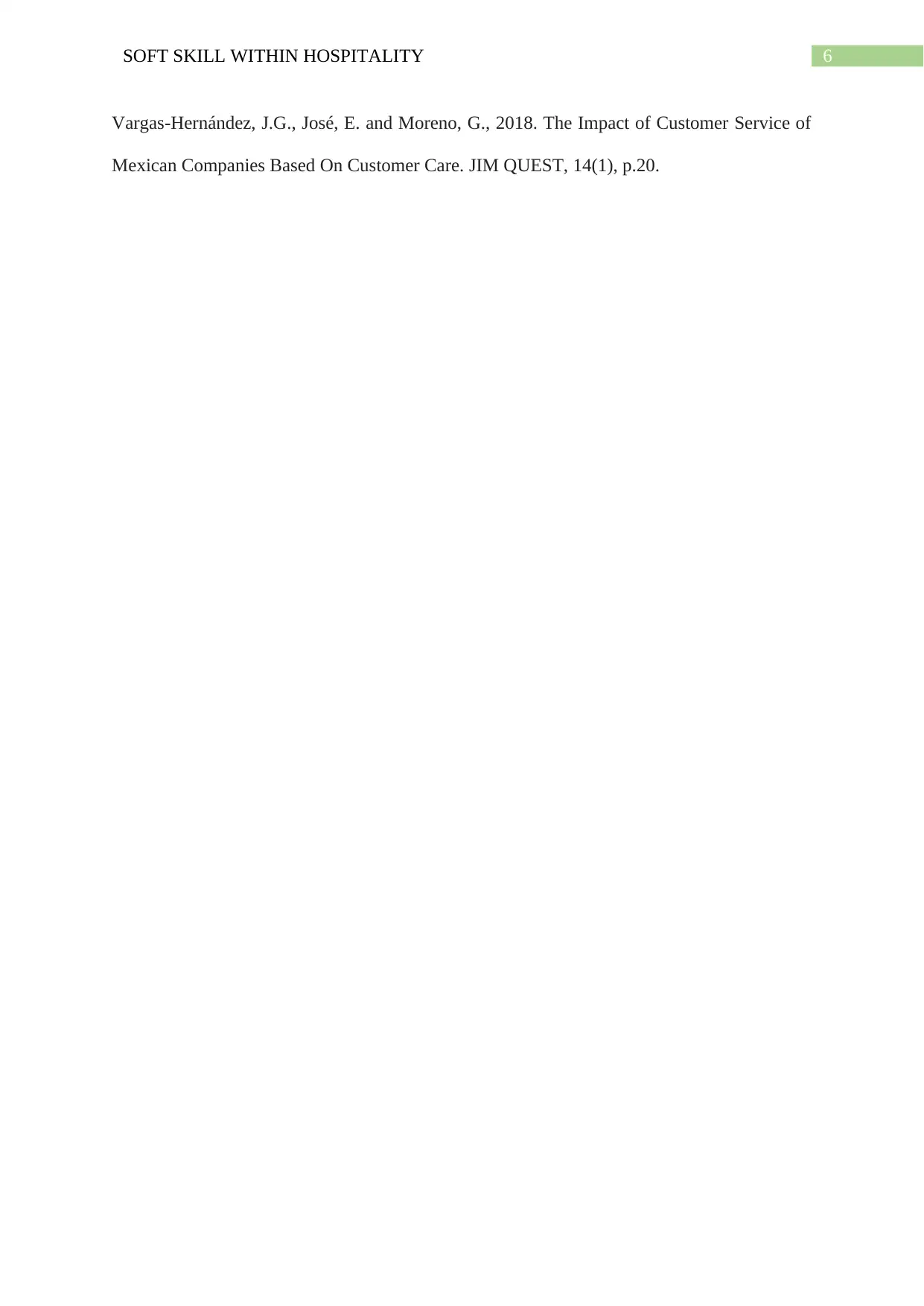
6SOFT SKILL WITHIN HOSPITALITY
Vargas-Hernández, J.G., José, E. and Moreno, G., 2018. The Impact of Customer Service of
Mexican Companies Based On Customer Care. JIM QUEST, 14(1), p.20.
Vargas-Hernández, J.G., José, E. and Moreno, G., 2018. The Impact of Customer Service of
Mexican Companies Based On Customer Care. JIM QUEST, 14(1), p.20.
1 out of 7
Your All-in-One AI-Powered Toolkit for Academic Success.
+13062052269
info@desklib.com
Available 24*7 on WhatsApp / Email
![[object Object]](/_next/static/media/star-bottom.7253800d.svg)
Unlock your academic potential
Copyright © 2020–2025 A2Z Services. All Rights Reserved. Developed and managed by ZUCOL.

